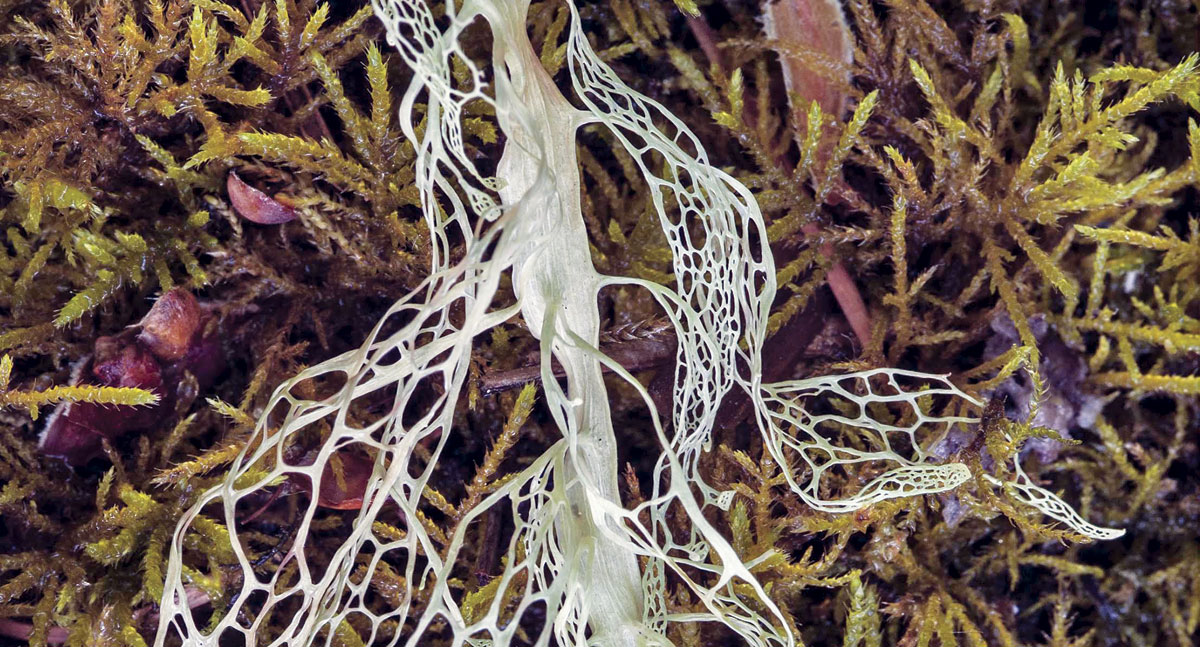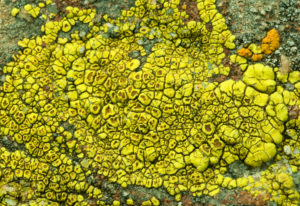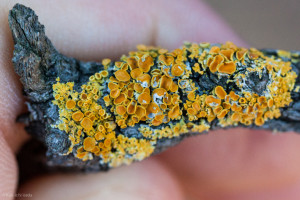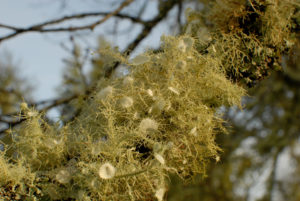In July, Governor Jerry Brown signed into law a bill declaring the lace lichen—found along the Pacific coast and throughout the coast ranges—the state lichen. As of January 1, 2016, California will be the first state ever to designate a lichen as a state symbol.
Lace lichen, Ramalina menziesii, is easily recognized. It is pale green and dangles in strips from trees. It’s sometimes confused with Old Man’s Beard (Usnea sp.), which is also pale green and dangly. Lace lichen’s range stretches from Alaska to Baja California. It’s an important food for deer; it also serves as material for birds’ nests. I see it once, in researching this story, when naturalist Morgan Evans, a former student naturalist aide at Tilden Nature Area in the East Bay hills, removes it from her backpack and spreads it out. Evans is a pleasant and patient woman, whose true love is fungi. Her interest in lichens is an extension of that, she says. Anyway, she found some lace lichen growing in Morgan Territory Regional Park. She figured I’d want to see it and there isn’t much growing in Tilden that she knows of. She hands me the lichen, which feels strangely plasticine. It’s pale green—she wetted it so it wouldn’t crumble when she transported it—and dangles impressively, at least six inches long. Lace lichen can grow as long as a meter, and it has a netted structure that looks, to me at least, more like fishnet stockings than lace. Perhaps fishnet-stocking lichen would be a little too racy a nickname.
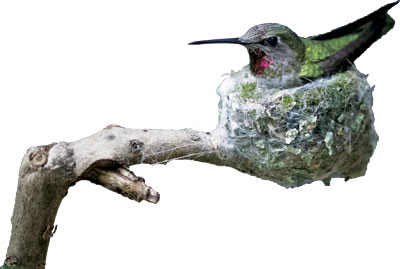
Before I tell you more, though, a disclaimer: It turns out lichen identity is fraught with existential issues, not least of which is that lichens are a union between two separate organisms. Basically lichens are fungi—that kingdom of non-plant, non-animal organisms—that have learned to tend algal or cyanobacteria cells like a farmer does a crop. Sometimes called a photobiont, the alga or cyanobacterium makes food for the fungus, manufacturing sugars from sunlight and carbon dioxide. In return, the fungus gives the algae a place to live, and in so doing, grows its fungal threads into the bodies of the photobiont, making it easier for the fungus to tap into the nutrients its partner produces. Though photobionts may live free of their keepers—and some do in Tilden, I learn—the fungus’ survival depends on the photobiont. Of the world’s roughly 25,000 lichen species, only a couple can live as a fungus sans its partner.
But scientists have probed what happens to the two organisms when separated in a lab and grown in cultures. For instance, Schizoxylon albescens is a fungus that can occur both as a lichen and as a solo act, a group of Austrian scientists found in 2011. A genetic analysis showed that the two versions of the fungus are not separate species. Studies have also revealed that once a lichen is broken into its constituent parts in the lab, they can’t be reunited. And researchers have no idea why. Maybe it’s because lichenization—the little-understood process that binds fungal spores and photobionts to create a lichen—may depend on yet another set of organisms: bacteria. It’s possible that bacteria are essential to lichens’ existence, making lichens more like an ecosystem than just a two-party party.
As of January 2016, California will be the first state with an official state lichen
Anyway, if you are feeling uneasy about identity, this is only going to get worse, as Evans tells me. “Species? That’s difficult,” she says. It’s hard to know precisely what species a lichen is without a hand lens or, in many cases, chemicals or a microscope, because what distinguishes different types of lichen are very tiny structures. Essentially, telling them apart comes down to examining the lichen’s structure by microscope; the chemicals help identify, by the color reaction, the presence or absence of chemical compounds, the signatures of various species. This necessity presents trouble for an amateur lichenologist, who might not want to tote a heavy guidebook—much less a microscope—into the field. Today here in Tilden, we have a hand lens, laminated papers, and a small guidebook from the California Lichen Society, and we’re going to do our best. You can usually at least get to genus this way.
As for the lichen I am about to attempt to identify: What is identity? I have a few things in common with the fungal partner in the lichen system. For instance, not all the nutrients I absorb are due to my own digestion. Plenty of the cells in and around my body that allow me to operate aren’t my cells at all. I have many bacteria—and some fungi—in what’s called my microbiota, and they’re useful for my continued health. Take gut bacteria, for instance. Most of us don’t notice they’re doing anything until we take a round of antibiotics. Antibiotics are indiscriminate—they’ll kill our helpful bacteria along with whatever’s ailing us. Many people suffer from diarrhea as a result of their lost gut bacteria, since they suddenly can’t process food as well; worse, without our helpers around, our guts become better homes for harmful bacteria like Clostridium difficile (also known as C. diff). I do not mean to denigrate the lichen’s status as a weird compound organism; it’s just that everything is a habitat—Tilden, your neighborhood, your stomach, your own face. It gets worse: Our genes show evidence that we actually absorb the genomes of some viruses into human DNA—if a sperm or egg cell is infected, the virus is incorporated into the fetus. Identity works only so long as you don’t look very hard at it; I have, at present, no explanation for how it functions whatsoever.
Are lichens fungus or alga? Oh, they are both, until it comes to the taxonomy. At this point we get down to business: They’re identified by the fungus. A fungus that, remember, occasionally sticks threads into its so-called partner, to more easily soak up nutrients. So, a fungus with digestive cells. In the middle of its structure. Does this setup sound familiar? A little, right? I tell this to Evans and she laughs. “Right!” she says. “We’re all composite organisms.”
She tucks away her lace lichen and we head out into the Tilden Nature Area to find some more. We won’t need to walk far or look very hard.

Though lichens appear varied, they mostly adhere to the same basic structure. A lichen’s body is called a thallus—as in, a thallus is to lichen as a body is to humans. Its outer surface is the cortex, where filaments of the fungus are packed densely to keep other organisms and the elements out. Below that is the photobiont layer, where the algae (or cyanobacteria, or both!) reside. And below that is the medulla—fungal filaments again; it’s not as dense here, probably to let air circulate. Some lichens have a second cortex below the medulla; others simply attach directly to the substrate, where the lichen lives. (Because lichens are really weird, and refuse to adhere to any rules, I should mention that so-called “jelly lichens” don’t have the nice layers that I set up for you. Jelly lichens are black and gooey, except when they are dry and brittle, and they have cyanobacteria as the “food-making” part. In this case, the cyanobacteria are distributed throughout the structure. Let’s not worry about them—we didn’t see them in Tilden, and they weren’t in Morgan’s flip-book of common lichens, either.)
Lichens aren’t great at forming fossils, so it’s hard to know their history. The oldest certain lichen fossil is from the Early Devonian period, 400 million years ago, and was found near Aberdeen, Scotland, in 1995. Across geographies and epochs, most lichens like to grow on stable surfaces they can adhere to—wood, rocks, cement. There are three major types of lichen: crusty (crustose), leaflike (foliose), and shrubby or hairlike (fruticose). Evans and I will see all three in the Tilden Nature Area.
Lichens can be thought of as air quality indicators. They easily suck up moisture and all the pollutants it carries, in particular nitrogen. Though nitrogen is a fertilizer, it’s also a pollutant, and some species love it, others not so much. The composition of a lichen community shifts in response to pollution levels. For example, nitrogen-loving lichens like Xanthoria candeleria have been spotted recently and newly in Yosemite, thanks to pollution coming from Central Valley agriculture.
Lichen plots all over the West Coast are observed by the U.S. Department of Agriculture for air quality and climate data. A 2008 USDA report specifically flagged the Bay Area for having “small hot spots of poor air quality,” based on its lichens. The report also indicated that the San Francisco Bay Area is the second-worst hot spot in the Central Valley monitoring area (right behind the San Joaquin Valley); 8 to 9 kilograms of nitrogen (per hectare per year) are deposited through rain and runoff in the Bay every year; the nitrogen critical load for lichens is 3.1 kg/ha/yr. Lichen communities in zones like this tend toward the bright orange Xanthoria, the sunburst lichens, and other nitrogen-friendly types.
Sure enough, Evans and I do find some Xanthoria polycarpa—the pincushion sunburst lichen, which looks like you’d imagine—on our hike, growing on a buckeye tree right next to the Environmental Education Center. Farther on we see what may be a Ramalina lichen of indeterminate species, which looks like miniature green threads sprouting bushily from a tree branch. It’s a shrubby lichen, which is considered “advanced” in lichen terms, Evans tells me. Perhaps you are now wondering, “What does ‘advanced’ mean to a lichen, which is not even capable of complaining about the weather?” Right, so: Lichens are 400 hundred million years old, and their history is not super clear, for the fossil-related reasons we discussed earlier. However! The shrubby lichens, these beardy-looking tangles, are structurally more complex from an architectural perspective and are therefore likely latecomers, evolutionarily speaking.
The Ramalina genus, of course, contains the lace lichen, as well as a few other lichens we see on our hike: Ramalina farinacea, also green, also bushy, but with little green nodules dotting the strands. (Its common name is dotted ramalina.) These bushy lichens grow most quickly, Evans says. I strongly suspect they also make the best imitation ZZ Top beards for those of us who cannot grow them; they are nicknamed the strap lichens, but I prefer to think of them as the chin-strap lichens.
Farther on: Chrysothrix xanthina, a.k.a sulphur dust lichen, a common bright-yellow crusty lichen that grows on tree bark. Crustose lichens are considered the most primitive form of the composite. They’re also known for creating soil: They’re the first colonizers of bare rock and cause the rocks to weather more quickly.
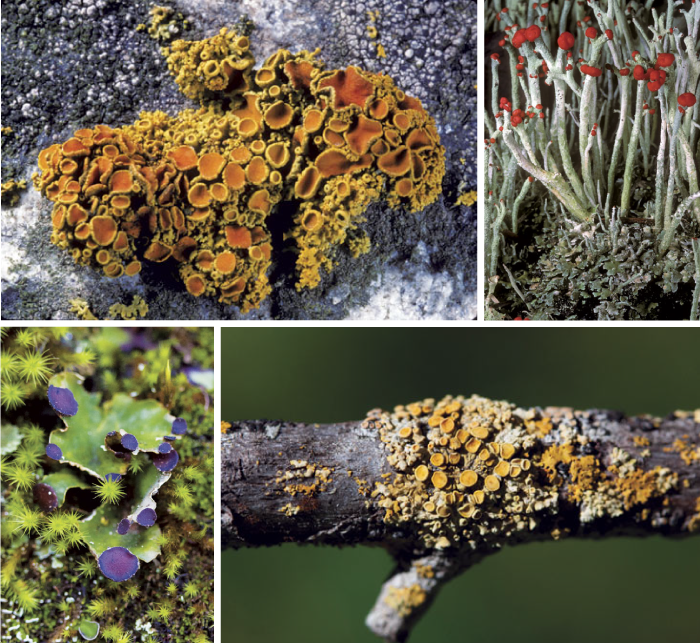
Most of the lichens we see on our walk are on trees, but then we get to an outcropping of blueschist, a relatively rare metamorphic rock. “You’ve got everything on these rocks,” Evans says, clearly delighted. And indeed, there are plenty of lichens growing—from Dimelaena radiata, a pale-white crustose lichen that looks remarkably like dried bird poop until examined with the hand lens, to Cladonia macilenta, a charming green lichen with little red packets on top. Those are the reproductive bodies, Evans says.
Well, reproduction. There’s the easy way to reproduce: dry lichen. Dry lichen crumbles, bits break off, it gets dispersed. The bits attach to a new surface and life carries on. Lichen can also reproduce sexually, but it’s oddly complicated. Only the fungus reproduces within the lichen. The photobiont can’t, thanks to some kind of suppression brought on by the fungus. Once the fungus reproduces, it creates fungal spores from the disks, cups, bumps, dots, and squiggles that we all can see covering the thallus. Those microscopic fungal spores, let loose in the world, must find a new photobiont in order to survive. If this seems vague to you, that’s because no one has ever seen sexual reproduction in lichens. As discussed earlier, no one has observed lichenization in a lab, and given that a very powerful microscope is needed to see a fungal spore, we’ll never observe it in nature.
This is the lichen world’s version of Theseus’s paradox: Is an object that has had every part removed and replaced—as happened with the rotting boards of Theseus’s ship, per Plutarch—the same object?
The question of what constitutes an individual lichen, and what it is for a “lichen” to reproduce, actually gets even more vexing and existential. For instance: say two species of fungi both manage to capture free-living algae from the environment. The two fungal species may weave into a single structure, but remain genetically distinct while partnering with the algae.
And because it’s lichen we’re talking about, there’s one more complicating factor. Some mycobionts—that’s the fungus part of the lichen—are just badly behaved. Take Diploschistes muscorum, for instance: It’s a parasitic lichen, and it starts its development on a Cladonia lichen, gradually replacing Cladonia filaments by growing over them and sucking energy from their algal partner, Trebouxia irregularis. At some point, though, the takeover is complete and Trebouxia irregularis is replaced by our Diploschistes’s preferred algal partner, Trebouxia showmannii. At that point, Diploschistes leaves off with the parasitism and behaves like any other lichen.
This is the lichen world’s version of Theseus’s paradox: Is an object that has had every part removed and replaced—as happened with the rotting boards of Theseus’s ship, per Plutarch—the same object? Philosopher Heraclitus would say you can’t step in the same river twice, so these are different lichens; Aristotle would suggest that since the “what-it-is” of the thing has not changed, it’s the same lichen. Take the headache further: Let’s talk people. Most of the cells in your body—save some nerve cells—turn over in the course of your lifetime. Are you still the same person? Yes, right? But some people have absorbed a twin in the womb—we know this because they carry the absorbed twin’s genetic material. (If you have ever known a person who has different-colored eyes that aren’t the result of an injury, they have genetic material from an entirely separate human.) So: Are these people one organism or two? One, right? But there’s a whole separate genetic entity in there, just as Diploschistes is residing in Cladonia—though, obviously, the absorbed fetal twin doesn’t eventually take over every cell. But how do you tell when the lichen is Diplochistes and when it’s Cladonia? When is the exact moment of change?
So our identifications are somewhat inexact. Better not to think too hard about it.
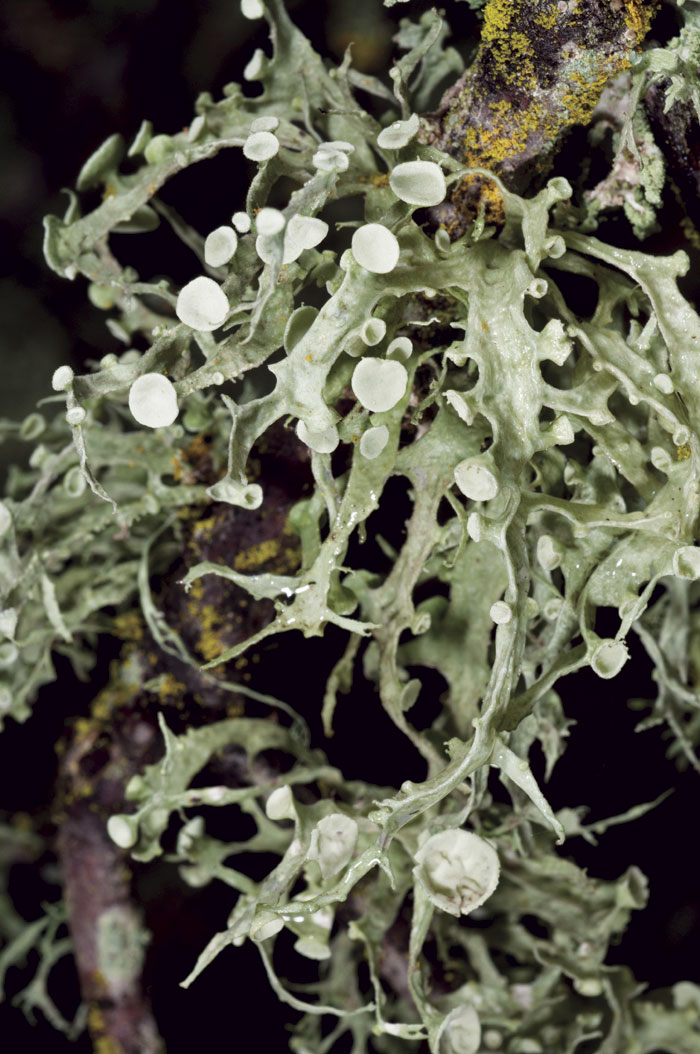
We walk on a bridge over the spillway from Jewel Lake, which is heartbreakingly low. Even here, we see granular, powdery-looking black packets—some kind of lichen, maybe—growing on the wooden footbridge.
Which is why, when I take my nightly stroll around Lake Merritt after saying my farewells to Evans, I suddenly notice how naked the trees look. It’s not that there aren’t lichens there—I’ve seen crusty ones. But that’s about it. Most of the lichens I find are Xanthoria tenax. When they’re wet, as the lichens around the lake are, they form little rosettes with yellow-orange surfaces. This species is common in areas with fog, but it’s also a nitrogen lover. And it’s known for handling pollution well. It frustrates and saddens me that our humbler parks are relatively barren of the weird dangling nonsense.
Before I left Tilden, Evans gave me a sample of a lichen we couldn’t quite identify. It’s green and bushy, with multiple flat strips growing from a vase-shaped center. Little cuplike nodules grow from the strips, and there’s brown-black spotting on the strips, which continue branching. I thought it looked familiar, I told Evans; I had a name on the tip of my tongue.
Once I’m home, this lichen immediately attracts the attention of my six-month-old kitten. She fishes it out of my bag and is about to begin seriously gnawing on it—whatever it is—when I rescue it and put it atop my bookshelf, out of her reach. And then I forget about it for a week.
It frustrates and saddens me that our humbler parks are relatively barren of the weird dangling nonsense.
When I remember I have a lichen sample on my bookshelf, I take it down. It’s hard and feels delicate—pale green. Possibly I have killed it. Then I remember how they dry and crumble and I run some tap water over it, holding it in the palm of my hand.
The damndest thing happens: The lichen begins to move.
The color changes, becoming a darker green—the photobiont coming back to life!—and the lichen itself sort of uncrumples. It is extremely creepy to feel the lichen move; I hadn’t expected it. Besides which—okay, I know lichens aren’t plants, exactly, but they are certainly plantlike, and how often do you expect movement from plants? I expect it about never, except in the case of carnivorous plants.
I successfully do not drop the lichen in my astonishment, though it’s a near thing. I’m beginning to feel bad for it: chewed on by a cat, dried out, put in a city environment with too many cars and too much air pollution. Then I notice the little cuplike structures on it seem to have grown in places—the lichen has been busy, it seems. It still looks familiar, and when I match it up with photos I see why. It’s probably a Ramalina, with flat strands branching from its base. I gently replace it on my bookshelf. That feels almost right. The bookshelf, of course, was once a tree, and so too were the books on it. They are not trees now, of course. (Unless they are: the genetic material did not change between tree and bookshelf, after all. Though I suppose the wood is now dead, and cured, and changed into something else entirely, with a wholly separate function.) I wonder how long the lichen will be able to enjoy its new habitat, the remodeled forest I keep in my house.

